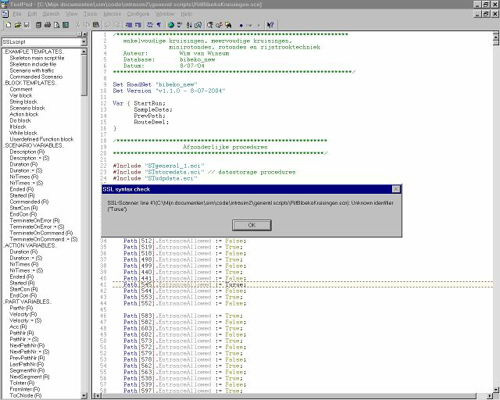StScenario
![]()
StScenario (a brochure is available on request) is the scripting language developed by StSoftware. The scripting lanuage is very versatile and easy to learn. The scripts are written in plain ASCII and parsed by StTraffic into efficient binary trees that are interpreted in real-time. This results in very high simulation frame rates in which a high number of scenarios can be simultaneously operating in real-time. ST Software provides a tool to assist the user in writing scenario scripts. The scripttool (a brochure is available on request) uses the commercially available third-party text editor ‘TextPad’ to create scenario script files. From this editor a program is called to perform syntax checks on the scenario scripts.

Here are some important features:
- The user defines a series of scenarios. A scenario is a predefined list of situations with a start and an end condition. The scenario becomes actived if a logical start condition evaluated to true. The scenario termines itself when a logical end condition becomes true. In the meantime, the scenario is active and all kinds of things can be done.
- The user can define any number of scenarios. Each scenario activates automatically when required and each scenario termines automatically when required. Any number of scenarios can be active at the same time, which may result in very complex simulations in which all complexity is handled by the specific scenarios.
- Scenarios may be reused by including them into the main script file. Because of that the same functionality can be used again and again in different simulations.
- All traffic is created by scenarios. Traffic participants are autonomous agents that are vehicles of varous types, bicyclists and in the near future also pedestrians. The initial positioning and removal of these agents is controlled by the scenarios. Also special properties, like the routes of these agents, are controlled by scenarios. The main principle is that as long as you don’t define anything for these agents, they behave natural, respect all rules and navigate through the database by themselves. However, their behaviour can be controlled completely if this is required by the user by changing the variables of individual agents. All intelligent agents are able to evaluate the situation they are, and choose the appropriate behavioural rules. Because each agent handles its own task, complexity is greatly reduced for the user.
- The user can choose between a left-hand driving system, as in England, and a right-hand continental driving system by simply calling a system procedure once.
- The script language gives access to all relevant driving simulator functionality via system functions and system procedures. This gives the user full realtime control in which the present state can always be checked dynamically.
- In contrast to various other driving simulators, our simulations are never static, because everything can be tested dynamically. This principle allows for example, that something happens if the simulator driver is three seconds removed from a specific intersection, or any intersection of a specific type. This is very important because it ensures that simulations are reproducable and comparable between different trainees, whether the trainee drives slow or fast.
- Feedback to the simulator driver can be done easily from script. Also, a number of script files are supplied with StScenario that monitor all driver behaviour, apply driver error categorization and send feedback to the userinterfaces.
- Binary datasampling and creating both binary and ASCII files can be done from script. All kinds of scientific data like time headway, time to collision and lateral position can be sampled and stored in files for off-line data analysis and visualization. In addition, data processing can done in real time during the simulations.
- The user can define UDP ports from within scripts and send data to other computers via these ports. Also, data from other computers can be read via user-defined UDP ports. By this the user can program applications that communicate with the simulator scripts and even control the simulator by applications that are developed by the user. This principle makes sure that the system is open to the user.
- StScenario is supplied with a number of script files for driving through databases and for generating traffic, and examples of a number of applications. The scripting language is fully documented, and the user documentation is included.